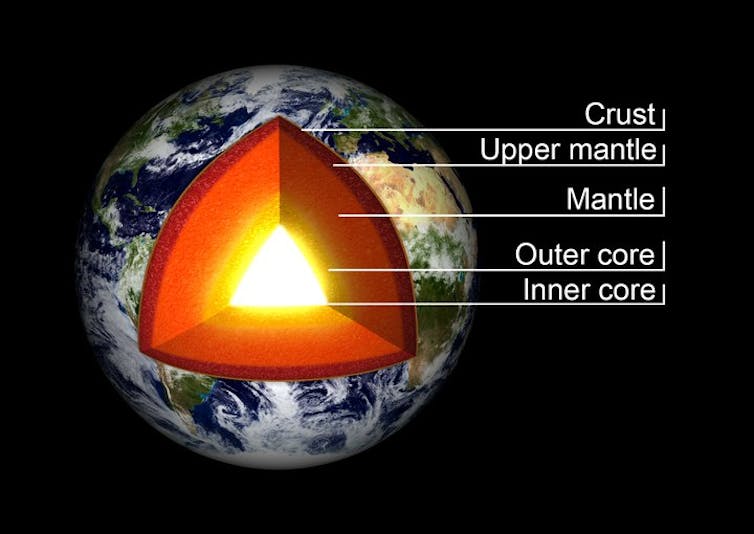Scientists have dated the birth of the Solar System to about 4.57 billion years ago. About 60 million years later a “giant impact” collision between the infant Earth and a Mars-sized body called Theia created the Moon.
Now, new research suggests that the remains of the large object that collided with the young Earth to form the Moon are still identifiable deep within the planet as two large lumps. These lumps make up about 8% of the volume of the Earth’s mantle, which is the rocky zone between the Earth’s iron core and its crust.
The new study, led by Qian Yuan of Arizona State University and Caltech, argues that the heat generated by this collision was not enough to melt the whole of the Earth’s mantle, so the innermost mantle remained solid.
Consequently, the researchers say, the melted mantle of Theia didn’t completely mix with Earth’s mantle. That would have made the Theia remnants indistinguishable from Earth’s mantle as a whole. Instead, a lot of Theia’s mantle ended up as two continent-sized lumps that now sit on top of the Earth’s core-mantle boundary.
Large low-velocity provinces
Yuan argues that these lumps correspond to, and can explain, the existence of the two large low-velocity provinces (LLVPs), that were discovered decades ago: one below the Pacific and another below Africa and the eastern Atlantic.
This discovery was thanks to the observation that the vibrations emanating from earthquakes, known as seismic waves, travel through these regions slightly more slowly than through “normal” lower mantle.

Previous explanations of the LLVPs include that each is a deep accumulation of subducted oceanic plates (where plate tectonics has dragged the ocean floor down beneath a continent). Or that they are a place where anomalously hot lower mantle is beginning to rise as a “superplume” (huge jets of partially molten rock).
However, neither of those models can account for a peculiar enrichment in volatile elements such as helium and xenon in lava that has erupted at oceanic islands above LLVPs. Yuan argues these are “fingerprints” of Theia’s growth within the gas and dust surrounding the young Sun before it collided with Earth.
Melting or not melting the whole mantle?
Computer models run by Yuan’s team suggest that the giant impact that formed the Moon would have not delivered enough energy to melt the whole of the Earth’s mantle. Instead, the melted remains of Theia’s mantle, which was slightly richer in iron (making it denser than Earth’s mantle) ended up at the base of the temporary magma ocean created by the collision.
Later, after the magma ocean had solidified, the Theia material was drawn into the lower part of Earth’s mantle by convection currents, which flow at rates of centimetres per year even within the solid mantle.
It may have taken billions of years for these convection currents to heap up the Theia material into the LLVPs that we see today. Even if this is true, they should not be thought of as vast chunks of Theia’s mantle that survived the impact. Rather, they are made of initially dispersed Theia mantle material that has been gathered up again.
Is it true?
Most scientists will take a lot of convincing when it comes to this theory. Yuan predicts that if his hypothesis is correct, samples of the Moon’s mantle, collected by future missions, will match the geochemical fingerprints found in volcanic rock from the LLVPs. I think that that proof will be a long time coming.
I also note that Yuan’s modelling seems to be silent on the fate of Theia’s core. Scientists usually assume Theia’s core merged with Earth’s core in the hours after the collision.
It is not clear how that could have happened if the lower part of Earth’s mantle remained solid. On the other hand, Theia’s impact happened so soon after the Earth itself was formed (probably by a series of separate collisions) that the Earth’s interior could still have been hot and molten in the aftermath of those events.
The implications of Yuan’s model are worth thinking about. For one thing, would the slow heaping up of Theia mantle material into the LLVPs have had any effect of on the pattern of plate tectonics high above? Possibly we would not have had an Atlantic ocean today had Theia not slammed into the proto-Earth four and a half billion years ago.
Read more: How the moon formed – new research

